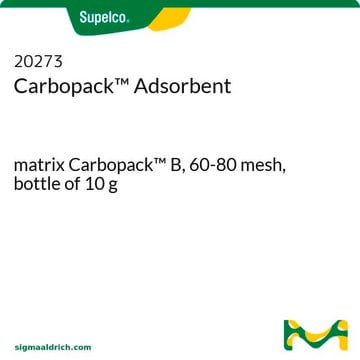28283-U
Carbotrap® 300 Thermal Desorption Tube
glass, O.D. x I.D. x L 6 mm × 4 mm × 7 in., fritted, preconditioned, pkg of 1 ea
Synonim(y):
Carbotrap® 300 glass TD tube, 7 IN, for Gerstel®
About This Item
Polecane produkty
product name
Carbotrap® 300, glass TD tube, fritted, O.D. × I.D. × L 6 mm × 4 mm × 7 in., preconditioned, pkg of 1 ea
Materiały
glass TD tube
agency
EPA TO-17
opis
Sealed with TDS³ Storage Container
linia produktu
Carbotrap®
Właściwości
fritted
preconditioned
opakowanie
pkg of 1 ea
charakterystyka ekologicznej alternatywy
Waste Prevention
Safer Solvents and Auxiliaries
Learn more about the Principles of Green Chemistry.
sustainability
Greener Alternative Product
metody
active air sampling: suitable
śr. zewn. × śr. wewn. × dł.
6 mm × 4 mm × 7 in.
macierz
Carbosieve S-III carbon molecular sieve (CMS)
Carbotrap® 300 (Packed with Carbotrap C, Carbotrap B, Carbosieve SIII)
Carbotrap® B graphitized carbon black (GCB)
Carbotrap® C graphitized carbon black (GCB)
Zastosowanie
air monitoring
environmental
industrial hygiene
kompatybilność
for use with Gerstel® TDS A & TDS 2
kategoria ekologicznej alternatywy
Szukasz podobnych produktów? Odwiedź Przewodnik dotyczący porównywania produktów
Powiązane kategorie
Opis ogólny
Informacje prawne
Kod klasy składowania
11 - Combustible Solids
Klasa zagrożenia wodnego (WGK)
nwg
Temperatura zapłonu (°F)
Not applicable
Temperatura zapłonu (°C)
Not applicable
Choose from one of the most recent versions:
Certyfikaty analizy (CoA)
Sorry, we don't have COAs for this product available online at this time.
If you need assistance, please contact Obsługa Klienta
Masz już ten produkt?
Dokumenty związane z niedawno zakupionymi produktami zostały zamieszczone w Bibliotece dokumentów.
Chromatograms
suitable for GC, application for air monitoringNasz zespół naukowców ma doświadczenie we wszystkich obszarach badań, w tym w naukach przyrodniczych, materiałoznawstwie, syntezie chemicznej, chromatografii, analityce i wielu innych dziedzinach.
Skontaktuj się z zespołem ds. pomocy technicznej






